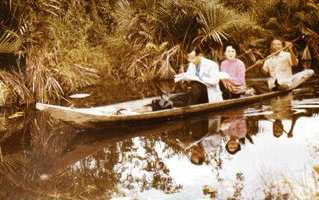
Visiting the Doi Inthanon Project at Chom Thong district, Chiang Mai province, on February 7, 1984.

Inspecting the Khek River Basin Development Project at Lom Sak district of Phetchabun province
(February 24, 1981).

A Ba Kong villager, Nut Anantranon, has been chosen to peddle the royal boat on the way to Ba Kong lotus pond.

Wherever he goes, His Majesty always carries maps to study the terrain of the place he is visiting.
- While staying at Klaikangwol Summer Palace in Hua Hin, Prachuab Khiri Khan Province, in 1963, Their Majesties the King and Queen visited a seaside village called Khao Tao in Nong Kae Subdistrict. There they saw how the villagers were plagued by chronic water shortage.
- His Majesty set out to find a solution to the problem, thus starting a string of projects aimed at providing water to drought-prone areas in various parts of the country. The King's logic is that if the people had enough water, for agriculture as well as for domestic consumption, they would stay where they are -- thus stemming mass migration from rural areas.
- At present the Rural Development Coordination Divition of the Office of the National Economic and Social Development Board coordinates the various royal-initiated rural development projects throughout the country. The projects cover everything from agriculture and fisheries, environment, public health, and communications to water resource development, with the latter taking the lion's share of the budget.
- The first royal-initiated project aimed at providing water for villagers was the construction of an earthen dam to block off sea water from seeping into waterways while preventing rainwater from flowing into the sea. The dam had a capacity of storing 600,000 cubic meters of water for irrigation and domestic consumption.
- That first project was followed by many others in nearly all the places visited by the King and Queen. Plans for the projects were mostly done by the King himself, after careful study based on data collected from various sources and from talking to villagers.
- Wherever he goes, His Majesty always carries maps to study the terrain of the place he is visiting. He then makes his own survey of the place and designs a plan for implementation by officials concerned.
- The royal-initiated projects are in response to people's petitions presented to the King during his visits to rural areas as well as to those sent to Office of His Majesty's Principal Private Secretary.
- Describing the projects, Her Royal Highness Princess Maha Chakri Sirindhorn siad in and interview: "In development a reservoir or irrigation system, comprehensive use of water is usually planned, such as for agriculture as well as domestic consumption. Lately, however, I've observed that His Majesty has been going into more details in water source development.
- His Majesty set out to find a solution to the problem, thus starting a string of projects aimed at providing water to drought-prone areas in various parts of the country. The King's logic is that if the people had enough water, for agriculture as well as for domestic consumption, they would stay where they are -- thus stemming mass migration from rural areas.